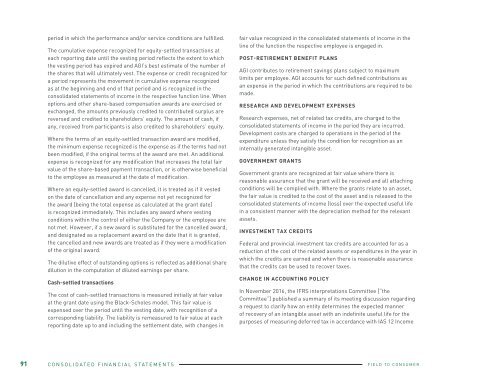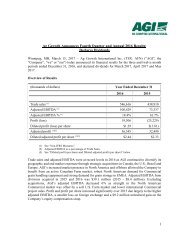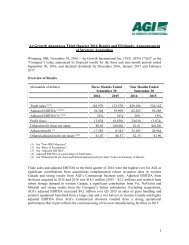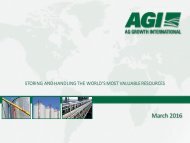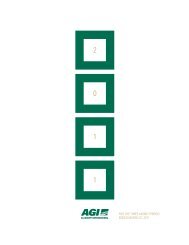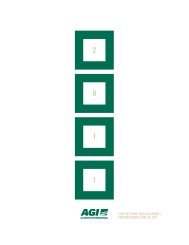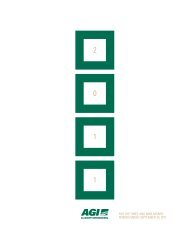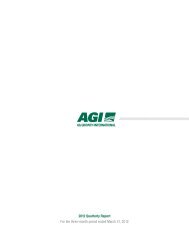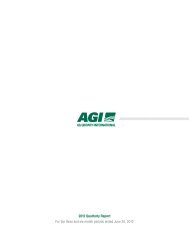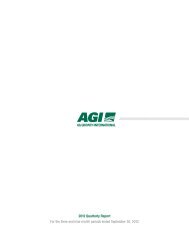2016 Annual Report For Web 7.3MB
Create successful ePaper yourself
Turn your PDF publications into a flip-book with our unique Google optimized e-Paper software.
period in which the performance and/or service conditions are fulfilled.<br />
The cumulative expense recognized for equity-settled transactions at<br />
each reporting date until the vesting period reflects the extent to which<br />
the vesting period has expired and AGI’s best estimate of the number of<br />
the shares that will ultimately vest. The expense or credit recognized for<br />
a period represents the movement in cumulative expense recognized<br />
as at the beginning and end of that period and is recognized in the<br />
consolidated statements of income in the respective function line. When<br />
options and other share-based compensation awards are exercised or<br />
exchanged, the amounts previously credited to contributed surplus are<br />
reversed and credited to shareholders’ equity. The amount of cash, if<br />
any, received from participants is also credited to shareholders’ equity.<br />
Where the terms of an equity-settled transaction award are modified,<br />
the minimum expense recognized is the expense as if the terms had not<br />
been modified, if the original terms of the award are met. An additional<br />
expense is recognized for any modification that increases the total fair<br />
value of the share-based payment transaction, or is otherwise beneficial<br />
to the employee as measured at the date of modification.<br />
Where an equity-settled award is cancelled, it is treated as if it vested<br />
on the date of cancellation and any expense not yet recognized for<br />
the award [being the total expense as calculated at the grant date]<br />
is recognized immediately. This includes any award where vesting<br />
conditions within the control of either the Company or the employee are<br />
not met. However, if a new award is substituted for the cancelled award,<br />
and designated as a replacement award on the date that it is granted,<br />
the cancelled and new awards are treated as if they were a modification<br />
of the original award.<br />
The dilutive effect of outstanding options is reflected as additional share<br />
dilution in the computation of diluted earnings per share.<br />
Cash-settled transactions<br />
The cost of cash-settled transactions is measured initially at fair value<br />
at the grant date using the Black-Scholes model. This fair value is<br />
expensed over the period until the vesting date, with recognition of a<br />
corresponding liability. The liability is remeasured to fair value at each<br />
reporting date up to and including the settlement date, with changes in<br />
fair value recognized in the consolidated statements of income in the<br />
line of the function the respective employee is engaged in.<br />
POST-RETIREMENT BENEFIT PLANS<br />
AGI contributes to retirement savings plans subject to maximum<br />
limits per employee. AGI accounts for such defined contributions as<br />
an expense in the period in which the contributions are required to be<br />
made.<br />
RESEARCH AND DEVELOPMENT EXPENSES<br />
Research expenses, net of related tax credits, are charged to the<br />
consolidated statements of income in the period they are incurred.<br />
Development costs are charged to operations in the period of the<br />
expenditure unless they satisfy the condition for recognition as an<br />
internally generated intangible asset.<br />
GOVERNMENT GRANTS<br />
Government grants are recognized at fair value where there is<br />
reasonable assurance that the grant will be received and all attaching<br />
conditions will be complied with. Where the grants relate to an asset,<br />
the fair value is credited to the cost of the asset and is released to the<br />
consolidated statements of income (loss) over the expected useful life<br />
in a consistent manner with the depreciation method for the relevant<br />
assets.<br />
INVESTMENT TAX CREDITS<br />
Federal and provincial investment tax credits are accounted for as a<br />
reduction of the cost of the related assets or expenditures in the year in<br />
which the credits are earned and when there is reasonable assurance<br />
that the credits can be used to recover taxes.<br />
CHANGE IN ACCOUNTING POLICY<br />
In November <strong>2016</strong>, the IFRS interpretations Committee [“the<br />
Committee”] published a summary of its meeting discussion regarding<br />
a request to clarify how an entity determines the expected manner<br />
of recovery of an intangible asset with an indefinite useful life for the<br />
purposes of measuring deferred tax in accordance with IAS 12 Income<br />
Taxes. Although the Committee decided not to add this issue to its<br />
agenda, the Committee noted that an intangible asset with an indefinite<br />
useful life is not a non-depreciable asset because a non-depreciable<br />
asset has an unlimited [or infinite] life, and that indefinite does not<br />
mean infinite. Consequently, the fact that an entity does not amortize<br />
an intangible asset with an indefinite useful life does not necessarily<br />
mean that the entity will recover the carrying amount of that asset only<br />
through sale and not through use. As such, the Company changed its<br />
accounting policy retrospectively for the accounting of deferred tax<br />
on intangible assets with indefinite useful lives to be in line with the<br />
Committee discussions.<br />
The following table summarizes the impact of adopting this change<br />
of accounting policy retrospectively on the consolidated statements<br />
of financial position. The change of accounting policy did not have an<br />
impact on the previously reported consolidated statements of income or<br />
consolidated statements of cash flows.<br />
INCREASE (DECREASE)<br />
4. SIGNIFICANT ACCOUNTING JUDGMENTS,<br />
ESTIMATES AND ASSUMPTIONS<br />
<strong>2016</strong><br />
$<br />
2015<br />
$<br />
Goodwill 997 6,181<br />
Deferred income tax liabilities 977 8,744<br />
Deficit — (2,563)<br />
The preparation of the consolidated financial statements requires<br />
management to make judgments, estimates and assumptions that<br />
affect the reported amounts of assets, liabilities, income, expenses<br />
and the disclosure of contingent liabilities. The estimates and related<br />
assumptions are based on previous experience and other factors<br />
considered reasonable under the circumstances, the results of which<br />
form the basis of making the assumptions about carrying values of<br />
assets and liabilities that are not readily apparent from other sources.<br />
However, uncertainty about these assumptions and estimates could<br />
result in outcomes that require a material adjustment to the carrying<br />
amount of the asset or liability affected in future periods.<br />
The estimates and underlying assumptions are reviewed on an ongoing<br />
basis. Revisions to accounting estimates are recognized in the period<br />
in which the estimate is revised if the revision affects only that period,<br />
or in the period of the revision and future periods if the revision affects<br />
both current and future periods. The key assumptions concerning the<br />
future and other key sources of estimation uncertainty at the reporting<br />
date that have a significant risk of causing a material adjustment to the<br />
carrying amounts of assets and liabilities within the next financial year<br />
are described below.<br />
IMPAIRMENT OF FINANCIAL ASSETS<br />
Assessments about the recoverability of financial assets, including<br />
accounts receivable, require significant judgment in determining<br />
whether there is objective evidence that a loss event has occurred and<br />
estimates of the amount and timing of future cash flows. The Company<br />
maintains an allowance for doubtful accounts for estimated losses<br />
resulting from the inability to collect on its trade receivables. A portion<br />
of the Company’s sales are generated in overseas markets, a significant<br />
portion of which are in emerging markets such as countries in Eastern<br />
Europe. Emerging markets are subject to various additional risks,<br />
including currency exchange rate fluctuations, economic conditions<br />
and foreign business practices. One or more of these factors could<br />
have a material effect on the future collectability of such receivables.<br />
In assessing whether objective evidence of impairment exists at<br />
each reporting period the Company considers its past experience of<br />
collecting payments, historical loss experience, customer credit ratings<br />
and financial data as available, collateral on amounts owing including<br />
insurance coverage from export credit agencies, as well as observable<br />
changes in national or local economic conditions. Future collections of<br />
accounts receivable that differ from the Company’s current estimates<br />
would affect the results of the Company’s operations in future<br />
periods as well as the Company’s trade receivables and general and<br />
administrative expenses, and amounts may be material.<br />
IMPAIRMENT OF NON-FINANCIAL ASSETS<br />
AGI’s impairment test is based on value in use calculations that use<br />
a discounted cash flow model. The cash flows are derived from the<br />
forecast for the next five years and do not include restructuring<br />
91 CONSOLIDATED FINANCIAL STATEMENTS<br />
FIELD TO CONSUMER<br />
<strong>2016</strong> ANNUAL REPORT<br />
CONSOLIDATED FINANCIAL STATEMENTS 92


